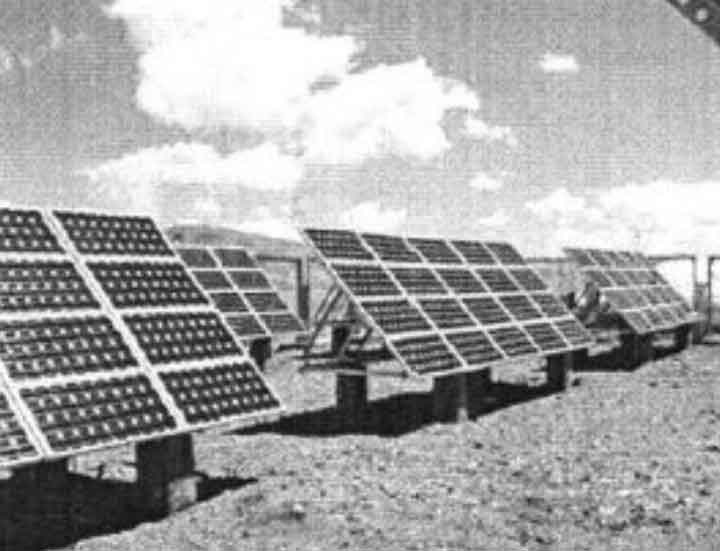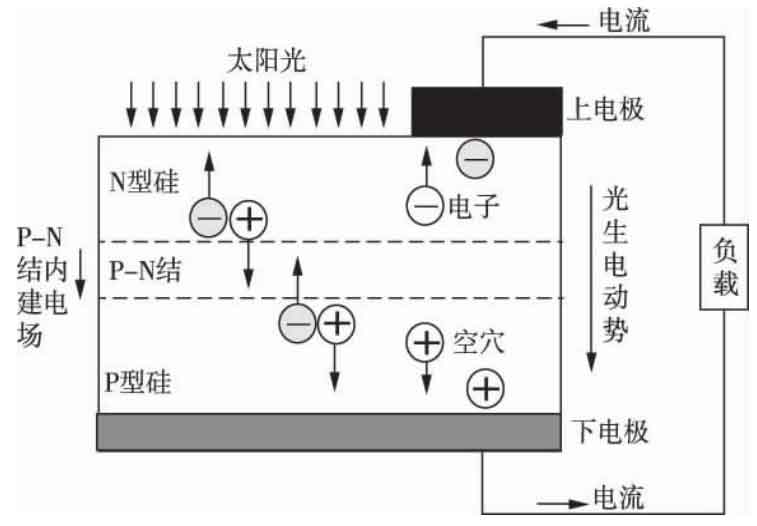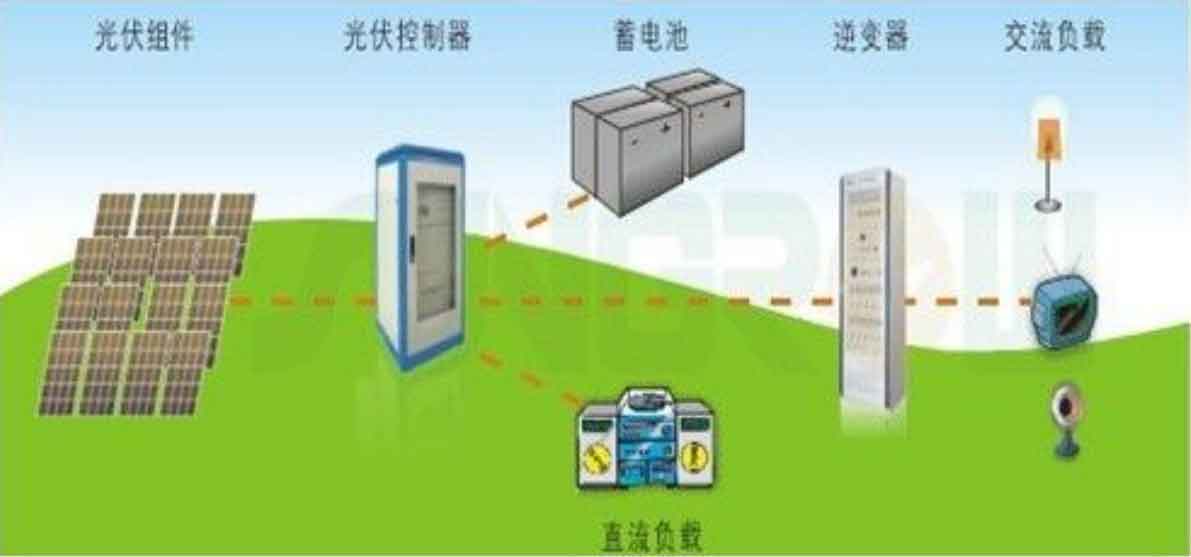The knowledge involved in design is particularly broad, such as the principles of photovoltaic power generation, output characteristics of photovoltaic cells, principles of photovoltaic inverters, maximum power point tracking principles, characteristics and principles of photovoltaic grid connection, and so on. These are all essential theoretical foundations for system design, with which one can correctly and completely design photovoltaic grid connected inverters.
1. Solar cells
The energy characteristics of solar energy have its particularity, as it belongs to radiation energy and cannot be stored. To convert it into convenient and versatile electrical energy, we need to rely on a device called a solar cell.
Since the birth of solar cells, it has a history of 61 years. Among the materials that can be used as solar cells, crystalline silicon is the most widely used. In fact, photovoltaic cells made from this material have always been the highest in production and the most widely applicable. In addition, with the rapid development of the photovoltaic industry, thin-film solar cells have become a popular target for the development of the new generation of solar cells due to their low cost, convenient large-scale manufacturing, considerable low brightness light conversion efficiency, and easy formation of photovoltaic integration. Photovoltaic cell arrays are the foundation of solar photovoltaic power generation. The specific form of the photovoltaic array is shown in Figure 1.

Solar cells are the foundation and necessary components of the entire photovoltaic grid connected system. Only with sufficient research and understanding of their characteristics can a photovoltaic inverter that meets the requirements be correctly and completely designed.
The photovoltaic effect is the fundamental principle for photovoltaic cells to complete energy conversion. The so-called photovoltaic effect is that light can cause some changes in the charge distribution state inside semiconductor materials, resulting in current and electromotive force. Solar power generation is achieved by utilizing the principle that light incident on semiconductors produces photoelectric effects, and its characteristics are basically similar to diodes. The principle is shown in Figure 2.

When photons with energy reach the surface of a photovoltaic cell, the light will interact with its internal materials. Meanwhile, electrons and holes are generated in the material as a result. Assuming that the semiconductor itself is a large PN junction, electrons move towards the N pole and holes move towards the P pole, ultimately converging at the two electrodes, where negative and positive charges separate and converge at the two ends of the semiconductor. If these two ends are connected by wires, there will be charges moving on the wires, generating electrical energy.
2. Solar photovoltaic power generation system
Photovoltaic power generation systems can be divided into solar off grid power generation systems and solar grid connected power generation systems based on their functions and application characteristics.
2.1 Composition and function of solar off grid power generation system:
(1) Solar controller: The function of a solar controller is to transfer energy to DC or AC loads on one hand, and on the other hand, it sends excess energy to the battery pack for storage. If the generated energy cannot meet the corresponding needs of the load, the solar controller will send the energy from the battery to the load. After the battery is fully charged, the controller should control the battery not to be overcharged. When the stored energy of the battery is released, the solar controller needs to control the battery not to be over discharged in order to protect the battery. The poor function of the controller has a significant impact on the service life of the battery and will ultimately affect the reliability of the system.
(2) Solar battery pack: The task of a solar battery pack is to store energy, making it convenient to ensure that the corresponding load can be used normally at night or on rainy days.
(3) Solar inverter: Solar inverter is responsible for converting DC electricity into AC electricity, and it supplies the corresponding
Using AC loads. Solar inverters are the core components of photovoltaic power generation systems. However, due to the relatively backward and remote construction of photovoltaic power stations, system maintenance is inconvenient. Therefore, in order to improve the overall performance of the photovoltaic power generation system and ensure the stable operation of the power station for a long time, very high requirements are put forward for the reliability of the inverter.
The system of off grid photovoltaic energy storage system is relatively simple and has a wide range of adaptability. However, due to its large battery volume and difficult maintenance, its usage range is limited.
2.2 Composition and function of photovoltaic grid connected power generation system:
The photovoltaic grid connected power generation system is different from the photovoltaic off grid power generation system. It does not require battery energy storage, but directly integrates the electricity generated by the photovoltaic array into the grid after a series of processing, and then transmits it to the grid. Due to the direct input of electrical energy into the power grid, it is possible to eliminate the need for corresponding batteries, thus avoiding the process of battery energy storage and generation. This allows for the full utilization of the electricity generated by renewable energy sources, reducing certain energy losses and ultimately lowering system costs. In addition, photovoltaic grid connected power generation systems can use both mains electricity and self generated electricity as the AC load power supply for this system, which can greatly reduce the system’s power outage rate. The photovoltaic grid connected power generation system has expanded its scope of use, reduced costs, and improved flexibility due to the omission of batteries connecting photovoltaic cells and power supply systems. A brief description of the advantages and disadvantages of solar photovoltaic power generation systems.
The advantages of solar photovoltaic power generation systems:
(1) The acquisition of sunlight is not limited by geography;
(2) Safe and reliable;
(3) . No noise and pollution;
(4) No need to consume resources;
(5) No need to install some long-distance transmission lines;
(6) The installation is very simple and convenient, and the construction period is relatively short;
(7) Distributed construction allows for on-site power generation;
(8) Facilitate financing and step-by-step implementation.
Disadvantages of solar photovoltaic power generation systems:
(1) Vulnerable to time cycles, meteorological conditions, and geographical limitations;
(2) The corresponding light energy conversion efficiency is relatively low;
(3) The cost of construction is relatively high.
3. Photovoltaic inverter
As the core component of photovoltaic power generation systems, the performance of photovoltaic inverters will directly affect the stability, reliability, efficiency, and cost of the entire system. The application diagram of inverters in photovoltaic systems is shown in Figure 3.

Characteristics of photovoltaic grid connected inverters:
3.1 Require high efficiency.
Because the current price of solar cells is relatively high, in order to make the most of solar cells and improve system efficiency, it is necessary to find ways to improve the efficiency of inverters.
3.2 High reliability is required.
At present, the construction of photovoltaic power stations is mainly focused on remote areas, so there may be deficiencies in maintenance and supervision. Therefore, reliability is crucial. In this case, a reasonable circuit structure and appropriate selection during the period are necessary for a successful inverter.
The inverter not only has the function of direct AC conversion, but also has the function of maximizing the performance of solar cells and system fault protection, namely:
(1) Anti standalone operation function
(2) Automatic operation and shutdown functions;
(3) DC detection function;
(4) Maximum power tracking control function;
(5) DC grounding detection function.
4. Maximum power tracking principle
To significantly and comprehensively improve equipment efficiency, we hope that solar modules can always remain at the maximum power point in the current environment. However, since the maximum power point always changes with the external environment and its own temperature, the system should have a tracking link for the maximum power point of solar modules. For the convenience of analysis, a simplified equivalent photovoltaic module is drawn here as shown in Figure 4.

In Figure 4 (a), the boost chopper circuit of the inverter’s front-end DC/DC is shown, where the duty cycle of the IGBT transistor is D when turned on. Here, we consider the front-end chopper DC/DC converter as a DC transformer. After making this equivalent treatment, if we set the transformation ratio to k, we can obtain:

If we consider the circuit in the dashed line as a whole, then this whole can be equivalent to a load impedance ‘RL’. Based on circuit knowledge, it can be concluded that:

Based on the research on the relevant characteristics of photovoltaic modules in the previous text, the conclusion is drawn that when environmental conditions are constantly changing, the output state of photovoltaic modules will also change accordingly. If the time period we set is short enough, it can be considered that the environment has not changed during this period, and it can be inferred that the output characteristics of the solar panel remain unchanged during this short enough period, and R can also be considered as constant.
According to relevant knowledge in the circuit, when R=’R, the load resistor obtains maximum power. Due to the theoretical fact that the boost circuit of the front-end DC/DC does not absorb active power, all power is transmitted to the load resistor R. And we can also adjust the duty cycle D by adjusting the PWM waveform output by the control chip, thereby adjusting the size of the equivalent load resistance R. In other words, it is necessary to match the equivalent load resistance ‘R’ and ‘R’ by adjusting the duty cycle D, at which point the load resistance can obtain maximum power, thus enabling the solar array to operate at the maximum power point. Then, by continuously measuring the voltage between a and b and the current flowing through R, the current R can be calculated to obtain the power. Through this promotion, we can adjust the duty cycle D by adjusting the PWM waveform output by the control chip at any time, ultimately achieving maximum power through load resistance and achieving maximum power point tracking control.
5. Main research and design content
The main content of research and design is as follows:
1) The background of researching photovoltaic grid connected inverters, as well as the research situation and market prospects at home and abroad in this area. Widely read relevant materials and various literature, collect and analyze relevant technical knowledge used in photovoltaic grid connected inverter systems.
2) Research and optimize the structure and inverter method of existing photovoltaic inverters to determine the overall structure of the photovoltaic inverter in this design.
3) Design hardware circuits such as auxiliary power supply, front-end boost and back-end inverter circuits, sampling circuits, driving circuits, and main control circuits based on the determined overall structure of the photovoltaic inverter;
4) Draw the system flowchart and complete the system software programming work by combining the designed hardware circuit and maximum power tracking algorithm.
5) Complete the physical production and debugging, and detect and analyze the final output waveform of the photovoltaic inverter.
